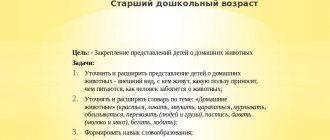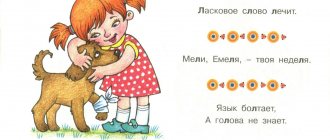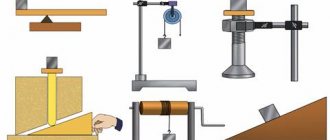Familiarization of preschoolers with words, syllable structure and stress.
Initial learning to read involves developing the ability to read in syllables (and not letters), i.e. mastering smooth syllabic, positional reading of words that children can understand. In this regard, familiarization with the syllabic structure of words occupies an important place in preparing children for learning to read and write.
The task of work in kindergarten is to develop in children
- awareness of the principle of the syllabic structure of a word,
-ability to hear and name the number of syllables in a word,
- determine their sequence,
-make words from given syllables.
This task is facilitated by the fact that the syllable is a pronunciation and word-forming unit of speech. When spoken, speech is quantized (quantization is the division of a range of values of a certain value into a finite number of intervals) in a syllabic manner.
At the same time, the skills of syllabic analysis are not formed immediately, since they, like sentence analysis, require complex mental actions. The matter is complicated by the fact that when teaching the syllabic division of words, children must be introduced to stress, which does not exist separately from syllables.
Linguists call a syllable the physical carrier of stress. Thanks to stress, the word is perceived as a sound unity.
The ability to hear and isolate a stressed syllable is necessary not only for preparing for learning to read and write, but also for mastering orthoepic norms, improving general speech culture, and for subsequent study of the native language at school.
In the methodology of teaching literacy, the sequence of work on dividing words into syllables has been developed in detail.
First of all, it is necessary to introduce children to the term “syllable” (at first the expression “part of a word” is used, since children confuse the concepts of “syllable” and “word”). If children often encounter the words word, sound, sentence in the process of everyday communication, when performing various speech exercises in the course of teaching different aspects of speech, then the word syllable is not known to them at all.
At the initial stage of work, two-syllable words are taken for analysis, consisting of direct open syllables, the pronunciation and spelling of which are the same (Masha, fox).
It is advisable to create situations in which the words are pronounced in a chant, drawing out the syllables (“A girl got lost in the forest, and they called her loudly: Ma-sha! Ma-sha!” The boys were walking and playing, their mother called them home: Sa-sha! Whoa! "). The children are asked to repeat what the guys' names were.
Thus, they come to the conclusion that words are not pronounced immediately, but in parts.
Familiarization with the syllabic division of a word can be built on the basis of an analogy with the division of a sentence into words, asking children to pronounce words with stops, in parts.
Another interesting technique for teaching children the new term “part of a word” is known in school practice: a fairy tale is told about the adventures of three brothers; to overcome various obstacles they had to say just one word in parts. For example: “They walked and walked. There is a stone wall and a gate in front of them, and a lock hangs on the gate. Ivan ordered the brothers to say one word, but in parts: lock. As soon as they said the word castle in parts, the gates immediately opened.”
Immediately after the perception and own pronunciation of words syllable by syllable, children are given the task of saying how many parts they heard in the word (two), which is the first, which is the second.
In this case, the teacher relies not only on auditory perception, but also on visual perception (how many times the mouth opens when pronouncing a word, there are so many parts in it), as well as tactile-muscular sensations (invites children to put their hand with the back of their hand under their chin: how many times will their chin touch hands when pronouncing a word, there are so many parts in a word). Here the word is graphically depicted on the board in the form of a horizontal line, divided in the middle by a small vertical line:
Other schemes are also possible; It is advisable to choose a model that will later be used when teaching at school. The teacher leads with a pointer according to the diagram, and the children pronounce the word in chorus in parts.
Children are shown, for example, two pictures with images of a fox and a squirrel, under which are given diagrams of the syllable structure of these words. Words are pronounced (in chorus and individually) in parts and analyzed. Children explain why there are identical diagrams under the pictures (these are diagrams of words divided into two parts).
Gradually, words consisting of three parts (ma-li-na, kar-ti-na) are introduced for analysis, and only then monosyllabic words (cheese, house), since they cannot demonstrate what part of a word is.
Children become familiar with monosyllabic words in a didactic game in which they classify pictures with names consisting of different numbers of syllables. Children are given pictures and asked to distribute them according to appropriate patterns, guided by the number of syllables. Pictures whose names are not divided into syllables must be placed next to another sign - a circle.
After completing the classification, the correctness of the task is checked and words assigned to the third group that cannot be pronounced in parts are discussed (example by F.A. Sokhin).
In the process of analyzing the syllable composition of words, children are introduced to stress. The concept of stress is given using the example of a two-syllable word with stress on the first syllable, for example the name of a child
Children are asked to pronounce this name first in chorus, then one at a time, loudly, and observe whether each part of it, each syllable, is pronounced with the same strength of voice. It is discovered that one syllable is pronounced with greater strength of voice, drawn out, that it is better heard. The teacher asks which part this is. The word is pronounced again with emphasis on the stressed syllable. The teacher draws the children's attention to the fact that the first part is pronounced with emphasis. Then, on the diagram of the syllabic composition of the word, an accent mark is placed - a slash over the first part (“Which part of this word is pronounced drawn-out, with greater voice power?” - “First.” - “So, the emphasis falls on it, and the dash above means that this syllable is stressed").
In subsequent lessons, children practice finding a stressed syllable in a word based on its diagram. When determining stress in words, children are shown its role. It is recommended to use the technique of alternately shifting the stress to each of the syllables, returning each time to the correct pronunciation: mish-ka, mish-ka; ma-shi-na, ma-shi-na, ma-shi-na. Children make sure which syllable is stressed. The teacher concludes that the word has only one stress; It is very important to correctly determine the stress in words. If the emphasis is placed incorrectly, then the word will not be recognized or understood what it means.
Stress is also demonstrated on syllable lines by displaying the windows corresponding to stressed syllables for a longer period of time, as well as on word diagrams using a pointer (its movement slows down when pronouncing a stressed syllable).
The ability to determine stress in a word is reinforced in a variety of exercises:
- graphic representation of a stressed syllable in different words;
- inventing words according to a given pattern (indicating the stressed syllable);
- pronouncing words at different tempos and with different voice strengths;
- classification of pictures whose names have stress on the first, second, third syllable.
How to teach your child correct word stress
How pleasant it is to communicate with a child whose speech is characterized by phonetic correctness, intelligibility and expressiveness. However, nowadays the speech of an increasing number of children is not characterized in a positive way at all. How often do we meet children at the age of three who, instead of detailed phrases that should definitely appear by this age, use individual onomatopoeia and babble. Many parents believe that this state of affairs is normal and do not pay attention to the recommendations of specialists. This is where they are completely wrong. Such children clearly have speech development delay (SDD), and it will be more and more difficult to eradicate it with each subsequent year.
New words, which will nevertheless appear as a result of targeted training (without it), will often be characterized by a violation of logical and verbal stress, distortion in the sequence of pronunciation of sounds, lack of intelligibility and legibility, etc. In our article we will introduce you to the directions of work on verbal stress, which is one of the elements of the phonetic system of the language, which is expressed in the emphasis of the main syllable through loud and prolonged pronunciation.
Features of word stress
The first feature of verbal stress in the Russian language is mobility, which consists in changing its place in a word.
The second feature of verbal stress is that within one word it can move from one syllable to another. For example, in the word “river” the stress falls on the second syllable, while in the plural in the word “rivers” the verbal stress moves to the first syllable.
The presented features contribute to high variability and expressiveness of speech. At the same time, in children of preschool age up to school, and sometimes even in primary school, there are cases of disturbances in the allocation of word stress.
Typical errors in the pronunciation of words by preschool children and their emphasis on verbal stress are: syllable-by-syllable pronunciation of a word with stress on each syllable; double stress; unclear pronunciation of all syllables of a word, incorrect placement of word stress, inconsistent with the norms of orthoepy.
Directions for working on word stress
The first direction is teaching the technique of highlighting a stressed syllable. In order to master this skill, you should learn to change the strength of your voice and highlight the stressed vowel sound for a longer time. For this purpose, it is recommended to train the child in reproducing various rhythms with simple syllables such as ta, pa, ma, for example, Tata, taTa, Tatata, etc. When reproducing rhythms, you can use an additional channel - the child’s tactile sensitivity. This helps to focus the baby’s attention on more intense vibration of the larynx and prolonged pronunciation of the stressed vowel sound.
In addition to this technique, it is advisable to use clapping of the rhythm while simultaneously correctly pronouncing the corresponding syllables. An effective methodological technique is also conducting with the hand in the air, which can be of two types: the movement of the hand accompanies each syllable of the spoken word, the stressed syllable is highlighted by a more energetic movement; the movement of the hand is accompanied only by the stressed syllable. As a result of using this technique, the child controls the location of the stressed syllable in the spoken word.
The second direction is to perform game exercises aimed at strengthening the ability to highlight a stressed syllable. Here are some examples: drawing up a word diagram from multi-colored squares (red - stressed syllable, blue - unstressed); selection of words according to a given rhythm; determining the place of stress in a word; inventing words according to a given pattern; accent placement, etc.
A little theory
Each word has its own stressed syllable, which is pronounced with slightly more force than all the others. This is the emphasis.
It is noteworthy that in Japanese the emphasis on a syllable is made using pitch, in Latin - by the duration of the vowel sound, and Russian, French, and English use stress.
But there are no clear rules regarding where to put the stress in a word, because in the Russian language it is free.
Here is what V. Pakhomov, editor-in-chief of the Gramota.ru website, says about this:
How to teach?
Be sure to teach your child to identify stressed syllables in words
There are several ways to teach your child the correct accent. You shouldn’t limit yourself to just one; it’s better to periodically resort to different types of activities. This way, the child will not have a feeling of heavy duty from these lessons, but will retain interest in work.
Games
Try to accompany the word with the image it means.
As you know, play is the main activity for children of preschool and primary school age. Why not use this feature to teach accent placement? Moreover, these games do not require additional funds, so they are convenient to play on the road or while walking.
- “Calling words.” Invite your child to take turns calling any surrounding objects by name. For example, “DEEEEErevo”, “KachEEEEli”, “SAAAAdik”. Choose two or three syllable words to begin with, then complicate the task.
- "Names." Very often children make mistakes in names. Therefore, together with your child, pronounce the names of acquaintances and friends.
- "We decorate words." This game is suitable for those children who already know how to read. Write words on cards and ask your child to color in the accent letter. By the way, this activity also trains reading skills.
- "Knock with a hammer." Sit next to the child and, while pronouncing the words, ask him to tap each syllable on his knee with a hammer, and on the stressed syllable the tap should be a little stronger than on the others. For fear of bruises, you can also knock on the table.
- "Guess the word". Tell your child words with the wrong accent; his task is to correct you and pronounce them correctly.
Counting rhymes and rhymes
Counting rhymes and short rhymes are a great way to remember the emphasis in words
It is not necessary to learn rhyming lines by heart; you can simply pronounce complex words. For example:
A painter is painting our walls. The shelves are made by stolYar .
Like our Martha's Scarves are all striped .
For older children, counting rhymes can be more difficult to choose:
Aty-Bati, the bridge is humpbacked, a gypsy , and the dancers ran away, a cockroach scared them.
Once a shaggy gorilla called . He was not friends with the gorilla, so he immediately hung up . to call him ; whoever calls , take him.
In the nursery, the children were playing around , the teachers were cursing: “Don’t play around, the strap will put you on the potty.”
One two three four five. To start , let's all stand in alphabetical : Ani, Vanya, Kolya, Rita. Those who don’t know the alphabet will make our calculations easier .
Exercises
Always check your child's work carefully
Exercises on the correct placement of accents should also be in the nature of a game, otherwise the baby will get bored.
- "Repeat after me". The child needs to shout out the word you say. It is precisely raising the tone of the voice that makes it possible to avoid the drawn-out pronunciation of all vowels, which many children “suffer from.”
- “Underline the stressed syllable.” For children who can write, you can try dictating words; their task is to write them down and add accents.
- "Correct mistakes". Pronounce words with the wrong accent so that your baby can correct you. It’s good if this exercise includes words that are not yet known - this way your little one will expand his vocabulary and train his linguistic intuition.
Zaitsev cubes
By putting words together using Zaitsev's cubes, the child learns to correctly identify the stressed syllable
If possible, use Zaitsev cubes. Their peculiarity is that on each side there is not a letter, but a syllable. Compose the words yourself and ask your child to put a special cube on the stressed syllable, or make the task more difficult: let the child put the syllables into words himself, highlighting the stress. This way you will also train your reading skills.
Video: Placing stress in words
Accent in Russian - DICTORY.com
Peculiarities of stress in the Russian language
(continued)
Unstressed words require a separate discussion
.
Function words and particles, as a rule, do not have stress in the Russian language. Some of them are monosyllabic prepositions and conjunctions; they are pre-stressed words, so-called proclitics. They are adjacent in pronunciation to the independent words that follow them, which have an emphasis: on the water, by the road, from the forest, along the way.
Others are monosyllabic particles and are enclitics, that is, post-stress words.
They are adjacent in pronunciation to the preceding word, which has an emphasis on it: someone came, tell me, I promised, you opened the door, will they come ?
In these combinations
,
become
enclitics
.
Sometimes the excuse takes a hit. on itself, then the significant word that follows it turns out to be unstressed. Most often they pull the blow on themselves. prepositions ON, FOR, UNDER, BY, FROM, WITHOUT. ON - on the water, on the mountain, on the hand, on the ear, on the winter, on the year, on the house, on the floor.
But such a transfer of the stressed vowel does not always occur.
We say go out to a pier
(but not
a pier
),
climb a hill
(but not
a hill
),
point to a door
(but not
a door
),
run aground
(but not
aground
).
Shifting the emphasis to a preposition, according to the norms of orthoepy, is possible when the combination of a noun with a preposition is part of a stable phrase or when it appears in an adverbial meaning and has an adverbial character. In the same case, when it is important to highlight the noun as the object to which the action is directed, and when this noun acts as a complement, the blow. does not switch to an excuse. For example:
believe the word, but: pay attention to the word “transformation”; lower the ship into the water, but: because of the glare of the sun it is painful to look at the water; this man is dishonest, but: a bandage was put on his hand; put the load on her shoulders, but: he put his palms on her shoulders; move the hat onto his nose, but: the juggler put a cardboard cylinder on his nose; The old man was hard on his ear, but the mother looked at the boy's ear.
We will say to take the sin on your soul
.
It's a steady turnover, and a punch. enshrined in it. But one cannot say: this is the amount of production per capita of the population.
We say
fall like snow on your
.
This is also a phraseological unit in which the emphasis is traditionally placed on the preposition. But you can’t say: he threw confetti on his friends’ heads.
Often the emphasis in Russian is transferred to the preposition NA when combined with numerals: nA two, nA three, nA five, nA ten, nA hundred, nA two, nA three.
But if there are two numerals next to each other with the meaning of approximate, such movement is a blow. does not happen: leave for two or three days, for five or six months, for two or three days
.
Pronouncing nA two-three, nA three-five
is incorrect.
The preposition remains unstressed even in the case when two numerals are connected by the conjunction OR: for two or three days, for five or six months, for two or three days.
The emphasis in Russian is not transferred to the preposition even when there is a clarification at the first numeral.
Compare: to leave for two months - to leave for two months and ten days;
business trip for a year - business trip for a year and three months; the meeting is scheduled for three o'clock - the meeting is scheduled for three hours and thirty minutes. Finally, it should be said that sometimes the content of the text suggests the need to save the punch. on a significant word, and not transfer it to a preposition. In a conversation about the work of the famous Russian composer, we talked about a suite for two
Russian themes (and not
two
).
The presenter specifically highlighted the word two
to draw the audience's attention to this.
FOR - for a leg, for a hand, for a winter, for a soul, for a city , for a night, for a day, for two, for three, for five, for seven, for forty.
But the same restrictions apply here:
hide your hands behind your back - hide behind your mother’s back; grab hands - grab hands and feet; You can get there in two hours - two hours and forty minutes.
By - by the forest, by the field, by the floor, by the nose, by two, by three, by a hundred, by two, by three.
The blow cannot be taken. on a preposition when combined with the numerals five, six, seven, eight, nine, ten...
forty
and complex numerals
eleven, twelve, five hundred, six hundred, etc.: for five hours, for six days, for nine rubles , for forty kopecks.
The accent is not transferred in the cases described above:
TWO-THREE plates, five-six people; two or three days, two or three days; two or three days, three and a half days; about two centners, but two and three tenths of a centner.
UNDER - under the feet, under the arms, under the mountain, under one nose, under the evening.
FROM -
From the house, From the forest, From sight, From nose .
WITHOUT -
without news, without dividing, without sense.
FROM -
hour From hour, year From year, From generation.
Some two-syllable prepositions are always unstressed. These are BECAUSE, FROM UNDER and prepositions with the runaway O: UNDER, NECESSARY, OBO, OTO, ISO - from behind the forest , from under the table, under me, about me, from everyone, from everyone.
Weak words
- these are those words that, although they have stress in the phrase, are weaker than those of independent words. This type of stress is called side stress. Many adverbial prepositions are weakly stressed words, such as AFTER, CIRCLE, PAST, AROUND, OPPOSITE, AROSS, ABOUT and others. The fact that these words receive only a weakened stress is clearly felt when compared with phrases in which these words, used as adverbs, become carriers of a normal stress:
the mother stood behind the children - the river remained behind; the train rushed past the fields - the car drove past; he waved after the bus - people shouted something after him; we will come after an hour - we will come to you after; there was a spring near the house - enough walking around and around.
A side stress (or secondary) is indicated by the sign “gravis”, in contrast to the main stress, indicated by the sign “acute”. Side kick. usually has the preposition THROUGH: to get through the thicket, through the thickets, through the fog.
Always carries a collateral blow.
and the preposition EXCEPT: everyone gathered except him; don’t take anything boring with you except books; In addition to birches, there were also linden trees.
Some verb forms and introductory words HAVE BEEN, HAVE BEEN, SO HAVE BEEN weakly stressed: I wanted to take up reading; We used to sit together in the evenings and talk; So he was planning to leave?
However, you should not get carried away with side accents. If the speaker's speech is kept at a moderate pace, the pronunciation of unstressed words is with a secondary stress, and weakly stressed words are pronounced with a normal stress. will create excessive accentuation, which only complicates the perception of speech and disturbs listeners.
Words with side stress
attract special attention. For the most part, each independent word has only one beat. But there are words with a large number of syllables and complex in composition, which also have a side effect. This is mainly:
words formed by adding two bases: all-metal, cranial-cerebral, indefinite leave;
words with some prefixes of foreign language origin:
anti -clerical, ultra-reactionary, dust jacket, remilitarization;
complex abbreviated words:
dredger , district council, obllit, energosbyt, party conference
.
If there are two stresses in a word, then the main stress will be located closer to the end of the word, and the secondary stress will be closer to the beginning. The distance of the main strike also matters. from the beginning of the word: man-hater, pastime , cotton gin
.
Widely used compound words, if they are small, usually do not have side stress: vacuum, drain, garden, water supply, black lake, grateful, far-sighted, land surveyor, centuries-old
.
No collateral damage. Such common words as earthquake, agricultural
and others are also pronounced.
Side stresses appear more often in words that are stylistically bookish: ( oath-crime, book-guarding
) and in special words: (
electronic vacuum, galvanoacoustics, radio report, film script, photo correspondent, mine
).
It happens that when forming a complex word by compounding the main blow. moves closer to the center of the word and ends up on a different syllable than it falls on in the word used independently. So, we say:
a fighter - but a hammerman, a swordsman; wave - but short-wave, long-wave; factory - but elektrozavodsky; forested - but sparsely forested; Imported - but long-distance; wired - electrically wired; seller - but bookseller; raftable - but timber raftable; creator - but poet; ear - but around the ear; colored - but monochromatic.
Complex adjectives and complex ordinal numbers, in the first part of which there are 3, 4, from 11 to 20, as well as 30, 40, 50, 60... 100, are often pronounced with two stresses (collateral - on the numeral): eleven-meter, fifteen- liter, seventy-kilometer, ninety-kilometer, hundred-thousandth.
With two side kicks.
in the first part and with the main emphasis in the second part, the complex words four-hundred-truble, electrical engineering, automotor
.
Always have a side effect. complex words written with a hyphen: rear admiral, wardroom, raincoat, yacht club.
Side stress may fall on some prefixes: OVER-, AFTER-, INTER-. But here, too, the degree of use of the word plays a role. For example, with a side kick. the words postharvest, postoperative, postpartum are
.
But it is absent from the words after tomorrow, after dinner, afterword
.
And in words with the prefixes BETWEEN - to SUPER - a side blow. always put: international, intersectoral, interplanetary; SUPER -DEPTH, SUPER-MOBILE, SUPER-SPEED
.
Side stress is necessary to correctly pronounce the corresponding vowels in a word. If you say the word hosmag
without a secondary blow., then it will sound like this:
hazmAk
.
The listener may not guess the meaning of such a word. Hence, collateral damage. performs an important semantic function. In addition, it plays a significant stylistic role. The appearance of a secondary blow. where it is not necessary, it indicates a colloquial style, for example: about the community, eightsOt, ninesOt.
In addition to the unacceptable vernacular coloring, such excessive stress makes the speech tedious and difficult to understand.
Visual and expressive capabilities
accents are widely used in journalistic and artistic works. The author gives the character a vivid description, showing the originality of his attack. and pronunciation. The social, national, professional affiliation of the character and the degree of his education are revealed. But in a stylistically neutral speech, deviation from literary norms is unacceptable. Normative verbal stress contributes to the correct perception and effectiveness of the spoken word.
Rules for setting accents.
For task No. 4 “Orthoepic norms”
Rules for placing stress in nouns.
1. Words of foreign origin, as a rule, in the Russian language retain the place of stress that they had in the source language. In English, stress is most often on the first syllable, while in French it is on the last. Therefore, English borrowings sound like this: genesis, marketing, management, porter; and the French ones are like this: engraver, dispensary, blinds, rubber, parterre, music stand, chassis.
2. In words denoting measures of length and ending in -meter, the stress falls on the last syllable: kilometer, centimeter, millimeter, decimeter.
3. In compound words with the second part -wire, with the general meaning of “a device for transporting any substance or energy”, the emphasis falls on the root -water-: gas pipeline, water pipeline, garbage pipeline, light pipeline. BUT: electric wire, electric drive.
4. In words ending in -log, the stress falls, as a rule, on the last syllable: dialOg, catalogue, monologue, necrology.
5. In verbal nouns, the place of stress is preserved that in the original verb from which they are formed: (faith) confess - religion ensure - provision.
6. In some nouns, the stress is fixed and remains on the root in all cases: aeroport - aeroports bant - banty - with bows accountant - accountants X - with X - Xs - Iksov cran - cranes lEktor - lEctors - lEctors tort - with tort - Cakes - cakes scarf - scarf - scarves - scarves.
7. In the noun bAloven the stress falls on the root. In all words formed from this word, the emphasis on -BAL-NE falls: pampered, pampered, pampered, pampered, spoiled, spoiled.
Did you find what you were looking for? Share with your friends!
Rules for placing stress in adjectives. 1. In some adjectives, the stress is the same as in the original nouns from which they are formed: plum - plum kitchen - kitchen sorrel - sorrel.
2. The stressed syllable of the full form of some adjectives remains stressed in the short form: beautiful - beautiful - beautiful - beautiful - beautiful unthinkable - unthinkable - unthinkable - unthinkable - unthinkable.
3. In some frequency adjectives with movable stress it falls on the root in its full form - singular and plural; and also in the short form - in the masculine and neuter gender. In the short form of the feminine gender, the emphasis shifts to the ending: right - right - right - right - right harmonious - harmonious - harmonious - harmonious - harmonious.
4. If the emphasis in the short form of the feminine gender falls on the ending, then in the comparative form it will be on the suffix -E- or -EE-: sick - sicker, strong - stronger, slender - slimmer. If the emphasis in the feminine gender is on the base, then to a comparative degree it remains there: beautiful - more beautiful, sad - sadder.
Rules for placing stress on verbs.
1. The stress in past tense verbs usually falls on the same syllable as the infinitive: gulyat - gulyal, gulyala hide - hid, hid.
2. In another group of verbs, the stress in all forms is fixed, and in the feminine gender of the past tense it moves to the ending: take - took, took, took, took to lie - lied, lied, lied, lied. took, took, poured in, burst in, perceived, recreated, drove, chased, got, got, waited, waited, occupied, locked, locked, called, called, lilA, lilA, lied, overstrained, called, poured, picked, began, drenched, hugged, overtook, stripped, departed, gave, recalled, responded, poured, called, poured, understood, arrived, tore, removed, created, tore, removed.
3. For the verbs put, steal, sneak, send, send, send, the emphasis in the feminine form of the past tense does NOT fall on the ending, but remains on the basis: klAla, krAla, stole, slAla, sent, sent. The exception is verbs with the stressed prefix YOU-, which always draws out the emphasis: lila - poured out, krAla - stole.
4. In verbs ending in -IT, during conjugation, the emphasis falls on the endings: -ИШ, -IT, -IM, -ITE, -AT/-YAT: turn on - turn on, turn on, turn on, turn on, turn on hand over - hand over, will hand, hand, hand, hand to get through - get through, get through, get through, get through, get through to bleed - bleed, bleed, bleed, bleed, bleed. The verbs are conjugated according to the same pattern: call, exclude, endow, tilt, mess up, call, ease, encourage, cheer up, borrow, surround, repeat, call back, call, drill, strengthen, pinch.
5. In the following verbs ending in -IT, the stress does NOT fall on the ending: osposhlit - oposhlyat inquire - inquire.
6. In verbs formed from adjectives, the stress most often falls on -IT: fast - speed up, sharp - sharpen, light - lighten, cheerful - encourage, deep - deepen. BUT: the verb to embitter, formed from the adjective evil, does not obey this rule.
7. In reflexive verbs, the emphasis in the past tense form often shifts to the ending or suffix (in masculine past tense verbs): begin - began, began, began, began to accept - began, accepted, accepted, began.
Rules for placing accents in participles.
1. In active past participles with the suffix -ВШ-, the stress, as a rule, falls on the same vowel that is in the word before this suffix: zhI vsh ii, nali vsh ii, posmotE vsh ii.
2. In passive past participles formed from the verbs bend, bend, bend, the emphasis falls on the prefix: bent, bent, bent.
3. In short passive feminine past participles, the emphasis falls on the ending: occupied, locked, inhabited, acquired, poured, encouraged, removed, created.
4. If the emphasis in the full form falls on the suffix -ЁНН-, then in the short form it is retained only in the masculine gender, and in other forms it moves to the ending: included - included, included, included, included dovezenny - dovezyon, dovezenA, dovezenO, brought populated - populated, populated, populated, populated. The participles change according to the same pattern: endowed, brought down, encouraged, disabled, repeated, divided, tamed.
5. In the full forms of participles with the suffix -T-, formed from verbs with the suffixes -O- and -NU- in the infinitive, the stress falls one syllable forward: poLOT - polo t y, prick - pricked , bend - bend y, wrap - wrapped .
Rules for placing stress in gerunds.
1. Participles often have stress on the same syllable as in the infinitive of the verb from which they are formed: set - having set, fill - gulf, take - occupied, begin - having started, lift - having raised, undertake - having undertaken, create - created.
2. In gerunds with the suffix -ВШ-, -ВШИ-, the stress falls on the vowel letter that stands in the word before these suffixes: nacha in , otdA in , podYA in , pribY in , nacha lice .
Rules for placing stress in adverbs.
1. The emphasis falls on the prefix DO- in the following adverbs: to the top, to the bottom, to the dry. BUT: absolutely, completely impossible. 2. The emphasis falls on the prefix FOR- in the words: in advance, after dark, after light. BUT: to envy is envious.








